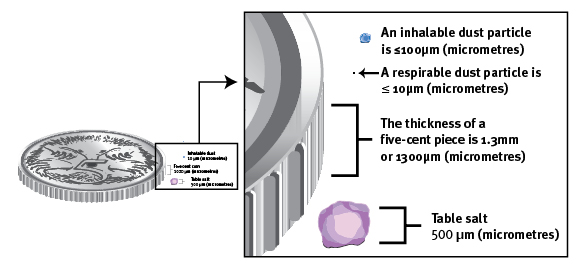In the perspective of workers, it's crucial to recognize that all airborne dust poses health hazards. Dust is a mixture of various materials such as sand, dirt, pollen, minerals, wood, micro-organisms, and exhaust from vehicles and industries.
Dust-related concerns are prevalent across diverse industries, stemming from numerous work activities. Examples encompass tasks like bag filling or emptying, weighing loose powders, cutting materials, sieving and screening, mechanical or manual material conveyance, stockpiling processed materials, crushing and grading, milling, grinding, sanding, cleaning, maintenance work, handling livestock feed, dealing with livestock and animal waste, and addressing spillages.
It's essential to note that different forms of the same material may pose varying hazards. For instance, a large piece of sandstone might present minimal risk, but when in the form of dust, it becomes hazardous.
The significance of particle size plays a pivotal role in understanding dust-related risks. Dust generated during work processes consists of particles ranging from large to very small. Larger particles quickly settle to the ground, minimizing the risk of inhalation. On the other hand, smaller dust particles, categorized as inhalable dust (smaller than 100 micrometres) and respirable dust (smaller than 10 micrometres), can stay airborne for extended periods. Inhalable dust affects the upper respiratory system, while respirable dust, due to its minuscule size, can penetrate deep into the lungs, potentially causing lung damage. Workers should be mindful of these distinctions to mitigate health risks associated with dust exposure.

Image 1: Particle sizes compared to a five-cent piece

Image 2: Respirable dust can only be seen under special light conditions such as when looking into a sunbeam while standing in a darkened room.
The size, composition, and airborne concentration of dust particles all contribute to the potential hazards they pose.The adverse health effects of dust span a range, from causing skin irritation to the development of conditions like lung cancer. Detecting dust as a hazard may not be straightforward, given that the particles are often invisible, and the health consequences may manifest over several years.
Regarding inhalation, the accumulation of dust in the lungs can initiate inflammation and, over time, the formation of scar tissue (fibrosis). This process may lead to breathing difficulties, with conditions progressing gradually, and symptoms may only become apparent once significant, irreversible changes have occurred.
Certain dust types, such as respirable crystalline silica (RCS), are notorious for causing severe lung diseases like silicosis and lung cancer. Long-term health impacts from lung exposure to dust are typically permanent and may result in disability. Consequently, prioritizing disease prevention becomes crucial.
Specific dusts, like those arising from grain, flour, wood, reactive dyes, and proteolytic enzymes, act as respiratory irritants and sensitizers. Exposure to these substances can induce occupational conditions such as asthma (characterized by coughing, wheezing, and chest tightness), rhinitis (manifesting as a runny or stuffy nose), and extrinsic allergic alveolitis (with symptoms including fever, cough, worsening breathlessness, and weight loss). Workers should be vigilant about these potential health risks and focus on preventive measures to ensure a healthier work environment.
How can breathing in dust affect you?
PneumoconiosisA group of restrictive lung diseases like silicosis, talcosis and asbestosis, where dust exposure causes debilitating lung scarring. | |
Chronic Obstructive Pulmonary Disease (COPD)COPD (also called Chronic Obstructive Airways Disease) is an umbrella term for long-term disease of the lungs including emphysema, chronic bronchitis and chronic asthma. | |
AsthmaAn obstructive lung disease, linked to exposure to irritants or allergens (sensitisers) at work. A reversible shortness of breath. | |
Extrinsic allergic alveolite (EAA)An allergic condition which affects workers exposed to biological dusts, causing conditions including farmers' lung and bird fanciers' lung. | |
Fibrosing alveolitisAlso known as pulmonary fibrosis, can be caused by some occupational dust exposures, for example work with cobalt or 'hard metals' in cutting tools. Related conditions, 'flock workers lung' and 'popcorn lung' are other occupational diseases that results in obstruction of the smallest airways of the lungs (bronchioles) due to inflammation. | |
CancersThe growth of abnormal cells, particularly of the lung and nose, are related to substances commonly encountered at work, including asbestos, silica, chrome VI, nickel, cadmium and wood dust. These account for thousands of work-related deaths each year. | |
Heart diseaseDust-affected lungs put extra strain on the heart which can lead to right-sided heart failure. Some occupational exposures, such as hard metal dusts, can cause potential fatal conditions like cardiomyopathy. Very fine dust particles cause inflammation of the heart and a higher risk of heart attacks. | |
Other problemsExposure levels that are half the allowable level for most workplace dusts can overwhelm the body's first line of defence, the mucociliary clearance that filters out dust in the upper respiratory tract. This can leave the worker more vulnerable to infections and more susceptible to occupational lung disease. Lots of other dust related conditions occur, some specific to particular exposures: beryllium is linked to sarcoidosis and chrome dust to chrome ulcers. | |
Skin Contact:Certain dusts, like epoxy resins, rubber processing chemicals, wood dust, and fibreglass, have the potential to induce skin issues such as ulceration, irritation, or sensitization leading to dermatitis.
Eye Contact:Dust particles, based on the material's chemical and/or physical properties, can bring about damage or irritation to the eyes.
Ingestion:When certain inhaled dusts accumulate in the respiratory tract's mucus, they are either expelled or ingested. Ingested dusts may reach the digestive tract, causing localized effects like irritation in the gastrointestinal tract. Additionally, these particles can impact other organs and tissues through the bloodstream, for example, substances like lead.
It is imperative for workers to uphold high personal hygiene standards, including regular handwashing, as dust particles may also find their way into the digestive tract through activities like eating, drinking, and smoking with contaminated (dirty) hands.
